You are using an out of date browser. It may not display this or other websites correctly.
You should upgrade or use an alternative browser.
You should upgrade or use an alternative browser.
HiBy RS8 Android Hifi Audio Player
- Added by third_eye
- Create date
MusicalDoc8
500+ Head-Fier
Pros: - Big and sturdy
- Titanium
- Powerful
- Detailed sound, as in you pay for the sound you get ALL the sound
- OS works flawlessly
- Options are plenty
- HiBy keeps upgrading it with new sound filters so it keeps evolving
- If all else fails you can use screws to open it up, just 4 screws to access the internals
- Great Heat Dissipation
- Titanium
- Powerful
- Detailed sound, as in you pay for the sound you get ALL the sound
- OS works flawlessly
- Options are plenty
- HiBy keeps upgrading it with new sound filters so it keeps evolving
- If all else fails you can use screws to open it up, just 4 screws to access the internals
- Great Heat Dissipation
Cons: - Could be used in self defence but it would be ruled as an overreaction
HiBy RS8. I landed on this technological marvel after having a taste of "now you know why that high end DAP was at such a bargain" in another player. So i saved, and started reading around what would be considered the DAP to end all DAPs.
First order of business: OS gotta be open, i need my apps to be installable by putting them as .apk. This killed a couple other valid choices, because i need my neutron player and sync apps.
Then was power: gotta power from the most humble of my IEMs to my LCD5.
Then, of course, sound quality: Go big or go home. I won't open my wallet for something that keeps me wanting. Even if i spend less, if i feel regret, i'd rather spend nothing.
Detail and a pitch perfect rendition are to me the two aspect i want in my dream DAP.
After that, it needs to be cool or at least have exceptional power and heat management. I came from a literal pocket cooker, and since i wanted to spend on something high end, it needed to have a long lifespan. If it feels hot to the touch, it's gonna die faster than desired, not going around the reality of batteries dying directly related to their operational temperature. That stuff has been already researched, deeply, so i looked at great heat management. In this case, it's in the form of a HUGE copper block, that surrounds the battery and then touches the exterior. This means heat is conveyed away from the battery, and it's isolated from the warmer parts of the DAP. Meaning, good heat dissipation and the wisdom of keeping the battery as chilly as possible. I think the only way to improve on this would be literal copper going all the way through.
And to sprinkle on all that, there's HiBy's extras: MSEB and Plugins. I never even have explored it all, so vast the choices are, but you can basically tweak the player's sound singature to be YOUR choice. This isn't some banale PEQ, this is literally molding the sound experience to suit your tastes deeply. I have yet to see other DAPs with such great care for user's customization.
So HiBy's RS8 has all that. Battery can last you an entire week, in one run i can keep it at turbo-power (highest power setting) and still get about 8 hours of balanced playback, using the internal memory.
I only ever listen to stuff i have stored locally through Neutron player, so my experience is purely local-player through Neutron. Nothing streamed, i don't buy a 3.500 euros player for streaming. My own opinion on streaming is that of contempt, possibly a controverse opionion but i won't lie to you about my tastes.
Never a hangup, great stability and, when i use the wifi sync app, a FOSS app, i had great reception speed with 5Ghz antenna, and not an issue on synchronizing the biggest songs i could find.
Thanks to all the magic sound vodoo it can do, i had to go and convert all my music to PCM, because before i was used to delta-sigma dacs so i preferred DSD, but got it all to 32bit PCM to make use of the internal filters.
Also, this player is a R-R that can also use DSD, but i FEEL (nothing proven just my own thought) that PCM would be a better choice, given the ability to "alter" them freely with filters.
All in all this player is a continuos source of satisfaction. Never once i regretted sinking so much money in it, because it gave me back so much. Maybe in the future there will be a V2 version with something magical but sincerely, this feels like a HUGE step forward and something that also has a sturdyness and well engineered layout that screams "I AM MADE TO LAST".
It would be an understatement to say that it's become my Gold Standard when trying new headphones/iem
It's THE reference sound, with power, detail and accuarcy that is second to none.
Now you might wonder why i don't analyze the effect of using it in different songs and scenarios. Truth is i have literally nothing that can top it in either detail or musicality. My humble A70pro + E70 velvet is really good, but this DAP would make me be able to just forgo all the fixed desktop equipment and enjoy a literal portable music hall, particularly when paired with my LCD5.
It would be boring to say in every single song that it's the best i've ever heard, but it's true. I think that, all in all, buying such a DAP would go a long way toward summit fi. Maybe it can't power a Susvara (and i don't own one) but to me this DAP paired with my LCD5 lets me bring my own private orchestra in the woods and enjoy nature with the most wonderful music i can bring with me. And i think it's one of life's luxuries to be able to enjoy the outdoors while listening to the most wonderful song in the most faithful way.
Reccomended is an understatement, it's wonderful and i think that it's a no-brainer.
First order of business: OS gotta be open, i need my apps to be installable by putting them as .apk. This killed a couple other valid choices, because i need my neutron player and sync apps.
Then was power: gotta power from the most humble of my IEMs to my LCD5.
Then, of course, sound quality: Go big or go home. I won't open my wallet for something that keeps me wanting. Even if i spend less, if i feel regret, i'd rather spend nothing.
Detail and a pitch perfect rendition are to me the two aspect i want in my dream DAP.
After that, it needs to be cool or at least have exceptional power and heat management. I came from a literal pocket cooker, and since i wanted to spend on something high end, it needed to have a long lifespan. If it feels hot to the touch, it's gonna die faster than desired, not going around the reality of batteries dying directly related to their operational temperature. That stuff has been already researched, deeply, so i looked at great heat management. In this case, it's in the form of a HUGE copper block, that surrounds the battery and then touches the exterior. This means heat is conveyed away from the battery, and it's isolated from the warmer parts of the DAP. Meaning, good heat dissipation and the wisdom of keeping the battery as chilly as possible. I think the only way to improve on this would be literal copper going all the way through.
And to sprinkle on all that, there's HiBy's extras: MSEB and Plugins. I never even have explored it all, so vast the choices are, but you can basically tweak the player's sound singature to be YOUR choice. This isn't some banale PEQ, this is literally molding the sound experience to suit your tastes deeply. I have yet to see other DAPs with such great care for user's customization.
So HiBy's RS8 has all that. Battery can last you an entire week, in one run i can keep it at turbo-power (highest power setting) and still get about 8 hours of balanced playback, using the internal memory.
I only ever listen to stuff i have stored locally through Neutron player, so my experience is purely local-player through Neutron. Nothing streamed, i don't buy a 3.500 euros player for streaming. My own opinion on streaming is that of contempt, possibly a controverse opionion but i won't lie to you about my tastes.
Never a hangup, great stability and, when i use the wifi sync app, a FOSS app, i had great reception speed with 5Ghz antenna, and not an issue on synchronizing the biggest songs i could find.
Thanks to all the magic sound vodoo it can do, i had to go and convert all my music to PCM, because before i was used to delta-sigma dacs so i preferred DSD, but got it all to 32bit PCM to make use of the internal filters.
Also, this player is a R-R that can also use DSD, but i FEEL (nothing proven just my own thought) that PCM would be a better choice, given the ability to "alter" them freely with filters.
All in all this player is a continuos source of satisfaction. Never once i regretted sinking so much money in it, because it gave me back so much. Maybe in the future there will be a V2 version with something magical but sincerely, this feels like a HUGE step forward and something that also has a sturdyness and well engineered layout that screams "I AM MADE TO LAST".
It would be an understatement to say that it's become my Gold Standard when trying new headphones/iem
It's THE reference sound, with power, detail and accuarcy that is second to none.
Now you might wonder why i don't analyze the effect of using it in different songs and scenarios. Truth is i have literally nothing that can top it in either detail or musicality. My humble A70pro + E70 velvet is really good, but this DAP would make me be able to just forgo all the fixed desktop equipment and enjoy a literal portable music hall, particularly when paired with my LCD5.
It would be boring to say in every single song that it's the best i've ever heard, but it's true. I think that, all in all, buying such a DAP would go a long way toward summit fi. Maybe it can't power a Susvara (and i don't own one) but to me this DAP paired with my LCD5 lets me bring my own private orchestra in the woods and enjoy nature with the most wonderful music i can bring with me. And i think it's one of life's luxuries to be able to enjoy the outdoors while listening to the most wonderful song in the most faithful way.
Reccomended is an understatement, it's wonderful and i think that it's a no-brainer.
Last edited:
Delitia
100+ Head-Fier
Pros: R2R DAC yet micro detailed
NoS Options
Lots of filter options
Class A and AB amp options
Turbo mode
Great build and modern UI
Great battery life
NoS Options
Lots of filter options
Class A and AB amp options
Turbo mode
Great build and modern UI
Great battery life
Cons: Despite large quantity of options, most are not impactful enough to alter the sound noticeably
Opening:
Thank you, as always, to Andrew and Musicteck for the chance to review this product, you can find the Hiby RS8 and other Hiby products at https://shop.musicteck.com/collections/hiby
Throughout this review I'll be using the Nostalgia Audio Tesseract via the Effect Audio Cleopatra II Octa (with JVC SpiralDot++, small, for tips) for all of my comparisons.
This DAP was purchased with the sole purpose of displacing/replacing my Cayin N7 for the Nostalgia Audio Tesseract. The intention was to obtain a ToTL DAP which would be able to bring out the strengths of the Tesseract amazing mids, quality BA bass and great treble and air but due to roll-off, not as prominent as I'd like. The issue with the N7 for me was 2 fold, one, the extreme lack of treble (very smoothed out/rolled off) and the noisy amp, which the Tesseract is very susceptible to. The RS8 has achieved in spades what I wanted out of a DAP for this great IEM (also available on Musicteck) by bringing not only a great tonality across the mids but a mildly elevated bass and more treble energy than the overly smooth N7. The half a point I removing is not due to the DAP or sound signature itself but the software which, while offering a lot of options, is criminally under documented and often has little to no impact in sound. But as noted below, I did not have the opportunity at this time, nor the desire to fiddle with a lot of the "EQ-esque" options offered as I simply despise EQ and how it generally sounds (the artifacts introduced are generally very noticeable to me).
I'm going to keep my comparisons to other DAPs shorter than I typically included due to the fact that this is my first R2R dac ever thus I want to keep comparisons to more similar dac/daps. For my comparisons I'll be including the Astell&Kern SP3000 and Cayin N7. I'll also do my best to compare Class A/Class AB amplifiers, but to put it out in the open, I much preferred Class AB to Class A thus all of my comparisons will be Class AB vs the DAP. I'll cover RS8 Class A vs AB mostly in bass/mids sections as that is where the majority of the differences are.
Packaging:
The RS8s packaging is excellent, keeping in mind that I received the "suitcase" version and not the suitcase-less one.
The package comes complete with the DAP, a metal ownership card, envelope with content checklist, screen protector and letter from HiBy, the included leather case, usb c to usb c charging cable and an adapter cable for usb c to rca.



Build Quality:
The RS8 is a large and heavy DAP even when comparing to others in the ToTL space. It's not too heavy for me to consider it not "portable" and size wise it isn't too big or unwieldy to pocket but the downside, sharing the same design philosophy as Cayin, is that all the ports are on the bottom side, so pocket use, the volume knob is going to be facing down, out of reach which is a pretty annoying facet of the design for me. However, unlike the N7, the charging port is at the very least isolated positionally and not underneath the 4.4mm socket. As mentioned the RS8 is a heavy DAP but the construction feels very solid and it has excellent heat dissipation, even when using turbo mode for extended periods of time, the RS8 remains only warm at worst. The full titanium body assists greatly with this heat dissipation but also adds to the weight and strength of the dap, a worthwhile trade off, in my opinion. The DAP is beautiful and the stock case is nice, but I've since ordered a Dignis case, as the closed metal back retaining the RS8s design is simply gorgeous and I own alcantara dignis cases for my SP3Ks and have been very happy with them.
The RS8 also uses android 12 so it has a very quick interface with no hang ups or problems. It also seems to utilize nova launcher to offer a customized UI with many custom app icons. Similar to the N7, the RS8 has a great dropdown menu with all "necessary" quick swaps readily available for the user to toggle between amp types, open Darwin settings and get to oversampling and other options.
My biggest gripe with the UI is the same I have with the N7, the android app close menu (normally a dedicated floating button on other android DAPs) is simply a swipe up menu, which is a shared action with the app drawer menu, so it takes a lot of finesse (and luck) to touch JUST the right spot to open the app close menu and not the drawer.

Technicalities:
SNR/Background:
The background on the RS8 is far from the darkest but it does retain a strong level of blackness but one should not really expect the darkest of dark backrounds from an R2R DAC. While using the Tesseract there is 0 audible hiss or noise even when using turbo mode, which I will note, seems to greatly help the Tesseract and it's 6 ESTs. With the N7, even low gain has some audible hiss/noise when audio is silent or between songs while the RS8 even high gain is silent. There is a distinct click/pop between switching songs at times, akin to the Shanling H7 (~$800 DAC/Amp), it's a minor annoyance at worst, though and in no way affects listening enjoyment or loud enough to be intrusive. Switching over to the Empire Ears Odin, the popping mentioned above is gone, so this seems to be an issue with how sensitive the Tesseract is to subtle noise, Odin remains silent with absolutely no noise, in any gain mode as well as turbo mode on. Noble Audio Ragnar, much like the odin is completely silent and has no issues either, which is not surprising given it's the least sensitive of these 3 iems.
Soundstage:
The soundstage of the RS8 is moderate. With the Tesseract in Class AB, the soundstage has comparable width to the likes of the iBasso DX320x with amp11mk2, however there is distinctly less depth and height which I attribute to the fullness of the sound from the R2R dac. I will note the height is better than the depth on this DAP, which for me, especially for its intended IEM pairing, is far more important. To note, none of this really impacts my enjoyment of listening especially when using the Tesseract as it is an IEM which excels at expanding the soundstage width already and has a lot of air which helps to balance out the fullness of the RS8s sounds and forward mids. When switching to the Odin, the Soundstage is comparable to my above assessment that the soundstage width is similar to that of the DX320x, while depth is slightly improved over the DX320x and slightly less height. A typical strength of the Ragnar is soundstage and with the RS8 the staging is wide, deep and tall but not comparable to the likes of other ToTL daps in the price range, but many users do not like an overly stretched or possibly "fake" sounding overly large staging, so for those users, this combination will be great.
SP3k (SS&CU): The SP3K wins in every department here, wider, deeper and greater height, not much to say as the SP3K has the distinct advantage of that absolute black background and more incisive notes so the stage and space is able to shine through more. Across all 3 iems, the tesseract, odin and Ragnar this remains consistent, especially on the Ragnar and Tesseract, the staging is very out of head.
Cayin N7: Wider width than the RS8 by a fair margin, about equivalent depth, maybe slightly in RS8s favor but overall less height. The N7 has always had great staging and is one of it's strongest attributes as a DAP, especially at it's relatively more "affordable" price range of $2,000. While these two DAPs are aimed at a similar natural analog sound, the RS8 is able to pull it off better, and part of that is due to the staging not being as stretched as the N7.

Dynamics/Transients:
The RS8 is a fairly strong contender here. The dynamic range of notes (quiets are low, louds are...well loud) is very good and you'll get a lot of micro and macro detail due to that separation but due to more forward mids and a rather punchy bass (many refer to this as "dynamics", so for consistency with others I'll be using it as such going forward, despite my disdain for the term since it should apply to dynamic range and ONLY that), especially in Class A and as noted in the soundstage portion, you'll get less of a feeling of full separation from top to bottom despite the good range . Class AB performs better in this space since the bass becomes less prominent, tighter and faster. The transient speed of this dap is not the fastest, especially when using NoS an given it's R2R implementation. This is my first R2R as i mentioned earlier, but from others reviews of the RS8 and other R2R dacs (such as the SE300), the RS8 seems to be a much stronger performer and closer to delta sigma DACs without losing the analog sound R2Rs are known for.
SP3K: When compared to the SP3K, I'd say the RS8 has a stronger level of dynamics especially in Class A but it has a much weaker range than the SP3K. The SP3K is also much tighter and faster sounding than the RS8 but to some it comes with a sacrifice and is referred to as more "digital" or fake sounding to them. I for one find the SP3K to be the best sounding DAP out on the market right now, despite some of its weaker amp qualities.
Cayin N7: The N7 has a weaker dynamic range but even more bass emphasis than the RS8 so you'll notice more punch to kick drums and other when using the N7. As for the transient speed of both, I'd say they are pretty on par with one another, maybe slightly in favor of the RS8, both DAPs go for a smoother, more analog tonality to their sounds and thus will naturally sacrifice some speed to achieve that.
Sound Profile:
I'll use the opening here to briefly cover the differences in sound between No oversampling and oversampling on, as these and the "Darwin Anti-Aliasing" features are the only two which I utilize and notice to make any discernable difference in the sound, plus the differences were fairly consistent through my listening so no reason to cover in each section. There is an option for "Enhanced Atmosphere" but both myself and other owners of the RS8 I have spoken to recently did not notice any difference with this on or off even after extensive listening.
NoS On: With No Oversampling turned on, the RS8 the sound is fuller, less tight and sounds as if a slight bloom is applied across the sound, making it seem a little veiled at times. The largest effect seems to apply to the vocals which gain much more roundness without necessarily losing any detail. It does lead to the surrounding bass and treble to sound more recessed in comparison, at times.
NoS off (Oversampling x16): Across the whole spectrum you'll immediately notice the sharper edge to all of the notes and a little more "definition". I don't notice too much, if any, degradation to either quality or staging and other technicalities. It's literally just a "sharper" image leading to the perception of faster transients, micro detail is all still there just slightly more difficult to hear at times due to the fuller/more rounded sound.
Darwin Anti-Aliasing Filters: The variety of filters here are all preference, flip through them as you see fit. I found changes to be nominal but noticeable based on the song. some were much more receptive to changes. I found the Tesseract to generally be very very receptive to any changes to sound signature, such as cable, dap, etc, when i tried rolling through the same filters with Noble Viking Ragnar, I DID notice the same changes, but maybe a little harder to discern. I personally found Darwin #9 to be the most to my tastes on average, but as stated, roll through them and play around to find what suits your iem/music the best.
When utilizing Darwin V2, especially the new "Ultra" present, there is a VERY discernable jump in bass quantity due to the (personally....) overly smoothed out treble response. This is not a setting that I enjoyed at all, but many users I've spoken to regarding the RS8 absolutely adore Darwin Ultra and you will too, if you find offensive treble from your iem or simply want a greater quantity of bass at the expense of treble. These results were consistent across Tesseract, Ragnar and Odin, with the biggest difference in the Tesseract and Ragnar as they have more discernable treble than the Odin, which is already very smooth.
Plug-ins/MSEB: I'm going to keep this extremely brief, as I could not listen to any of these for more than few seconds as the effect on the sound was difficult to listen to. The dynamics plug in....works, you can definitely get thumping bass if you want it with this but it comes at the expense of an extreme distorted, unnatural sounding experience, which, for me, is completely contradictory to what a ToTL R2R dac is all about. The sound stage plug in was also similarly distorted sounding and, unless i'm misunderstanding the purpose of this one, is supposed to make the stage larger/more grandiose but in all of my testing with Tesseract and Ragnar I felt the stage close in, with vocals becoming more forward. On odin these plug ins were less distorted sounding, as the odin is not as clear/high resolution as either the Ragnar or Tesseract but they were still, for me, completely unusable.
Bass:
The RS8 is quite bass elevated, though not to the degree to which it impacts the rest of the FR negatively (as the 320max can be without proper IEM/Cable pairing). Overall I'd say the sub bass is elevated more than the mid bass, which, for me, is good because I often find mid bass elevation can cause a muddy sound or one that conflicts with the lower mids. The difference between Class A and AB is quite noticeable on the RS8, Class A has less punch while also having greater quantity but for me this conflicts much the same way as the N7 did with the overall balance in tonality the RS8 has. Class A's greater bass quantity along with the greater smoothening of the mids causes the sound signature to be a bit TOO laid back, but if one wants a sound that is buttery smooth for background listening to just fade into their surroundings, this is definitely a good way to go. Class AB is the contrast, obviously, as it reigns in the bass, becoming tighter and a bit punchier with the mids following suit and being more incisive so greater detail is present.
The bass remains well controlled for BA drivers but I found when testing with the Viking Ragnar that the bass became a bit conflicting with the overall signature of the Ragnar, leading to a weird elevated bass, but very low mid bass and lower mids but then very in your face upper mids with treble being less incisive than I'm used to with the Ragnar (typically paired with SP3K SS), needless to say I did not enjoy the pairing. It is worth noting that I found the best pairing of my IEMs to be with the Tesseract despite the Unique Melody Red Halo also being a BA bass unit I did not find them to mesh well together as the RH is already very mid forward and needs extension on both ends to help bring out its potential.
The Empire Ears Odin's bass response with the RS8 was, surprisingly, not heavily bass thumpy as I expected it to be in class AB. The bass remained tight and well controlled without being intrusive, I believe this is because the RS8 is more sub bass focused without much of a mid bass emphasis, which is usually where Odin tends to struggle with. Much like the Ragnar I found the Odin to be somewhat lacking on the RS8. I firmly believe the RS8s best IEM pairings will be ones with an elevated midbass which will help tonally balance the RS8s sub bass and upper mids emphasis.
SP3K: The SP3K SS has a very tight, fast and has a good tactility but not as much punch as the RS8 in Class AB. The CU has a slightly greater elevation of bass vs the SS which brings it closer to N7/Class AB but still not as elevated in quantity. The SP3K (SS and CU) are able to reach deeper than the RS8. In terms of quantity, the RS8 is the clear winner but quality is subjective here, as the SP3k leans heavily toward a technical sound while the RS8 goes for more of an analog speaker sound. It is worth mentioning that I did not like the Tesseract synergy with the SP3K but I absolutely love how it sounds with the RS8.
N7: The N7 Class A vs Class A RS8, quantity wise, is in the N7s favor, sounding much more full and boomy. While Class AB compares more evenly, the RS8 is able to achieve an overall better balance of sub and mid bass while the N7 can still sound a bit too sub bass forward in Class AB. Overall I much prefer the bass presentation from the RS8 as it is better balanced and has a better tonality to it than the N7, which leans somewhere between an R2R DAC and delta sigma in sound.

Mids:
The RS8s main attraction is by far it's vocal/total mid presentation, they are elevated and forward in either amp class choice and have a fullness to them that lets more emotion flow through. But much like the N7, the RS8s mids are heavily influenced in their presentation by your choice of amp class. Within Class A the RS8 has very forward, smoothed vocal presentation, losing a bit of detail in favor of a very relaxed sound. In Class A the lower mids can be a bit more recessed sounding due to the increased bass quantity. Class AB luckily does not have this issue, the mids are more focused and are balanced far better with the bass so no micro detail is lost in the lower mid section.
Upper mids, despite their emphasis on both Class A and AB sound fantastic with female vocals never being shouty or nasally with any of my IEMs I paired, even the Odin. I found the Odins mids to be outstanding on the RS8, they were smoother and more rounded than I am used to hearing from it, which lead to a bit more lower treble being able to shine into the mix, granting the Odin much needed balance with it's low end. It's worth noting, while I typically did not switch from Class AB with other IEMs, I found Class A on Odin to actually be my preference. Class AB is still very natural sounding and retains that R2R analog nature but gains a tad more more tightness/micro detail due to a quicker decay of the surroundings. Either way you can't go wrong, it's fully preference.
The Ragnar is pretty well regarded for it's excellent mids and vocal performance (outside it's treble that it's known for) and on the RS8 they are appreciably natural and rounded much more than I'm used to hearing from the Ragnar. Now, while I personally do not like the overall presentation of the Ragnar via the RS8, due to the aforementioned imbalance, the vocals are top notch, remaining detailed and keeping a perfect center image and a decent sense of air surrounding them which is gently filled with micro details.
SP3K: The SP3K, much like the bass, is more incisive, a cleaner, darker, more detailed background with which to present the mids against. There is less fullness to the vocals but they retain a very natural and organic R2R-like presentation. The biggest difference here is in the fullness/size of the notes presented as their tonalities do not vary all that much from eachother.
N7: The N7s mids are even more forward than those of the RS8, they are also fairly bloomy in comparison with much less control and tactility to them. They feel less textured, as a result they also feel less detailed and the bloom/forwardness can be a bit much at times depending on the IEM and music you're listening to. The tonality, for me, is in favor of the RS8 as vocals especially sound more natural and less like they've been put through a speaker which is amplifying every negative quality present. I never tried the N7 with direct DSD files, so this MAY be a result of the upsampling to DSD from PCM but I don't know so wanted to note that here for potential listeners.
Treble:
As usual, anyone that's read my reviews knows that treble is my home and my love, and that it MUST be good for me to love the iem, dap or cable. No harsh roll offs, lack of sparkle or other to hamper my enjoyment, that or overpowering bass are the two instant kills to anything for me in audio. With that said, I went into the RS8 with a lot of recommendations from fellow Watercoolers here on Head-fi, despite my apprehension about an R2R dac having extended and sparkly treble, I trusted them and took the leap. I was not disappointed at all, I wanted a DAP to replace the N7 with similar bass impact, natural forward mids (as stated above, a MASSIVE improvement here for RS8 vs N7) but that had much better treble sparkle and extension and the RS8 delivered exactly that. The treble here is something rather special compared to even my favorite SP3Ks presentation. With the Tesseract, the air is fully utilized and the treble is wonderfully extended while remaining natural with a slightly longer decay and thus a greater sparkle within all that room offered by the 6 ESTs. For me, this is the second best treble presentation I've come across in a DAP, SP3K remaining #1, RS8 at #2 and DX320 Max at #3. There is wonderful amounts of detail and post ring to every cymbal hit that brings the level of realism to 11 on the RS8 though, and that's what I think anyone looking for an R2R dac is after so the RS8 delivers in spades.
As expected, the Ragnar's treble is great via the RS8 but due the the further rounding and increased bass response of the RS8, there is some loss of fidelity and overall detail in the upper registers, with lower treble taking a noticeable hit in micro and macro detail comparative to the SP3k.
Anyone that has listened to the Odin, or any EE IEM, knows that the treble is it's weak point, often recessed/lacking that sparkle or detail needed to assert itself in the mix. With the RS8, this doesn't change much but due to the greater extension offered by the RS8 and additional decay, i felt that the treble was actually more discernable than I've previously noticed. I think this effect is two fold though, the more tame mid bass along with the extension allows the lower treble to stand apart from the upper mids which also usually occlude this area of the FR a bit.
SP3K: The treble of both the SS and CU SP3K, to me, is the same. They both have an extremely well extended bright and sparkly treble that only has the smallest touch of smoothness at the end of the notes, taking any sharpness that some might be sensitive to off. The RS8 has very similar extension but where it differs is that it has a longer decay mixing into the background and fading away with a great sparkle and airiness. The two are very complimentary in their overall presentation and I don't think anyone could go wrong owning either or both depending on their IEMs. I'd personally label the SP3K the greater all-rounder though, as the RS8 was not as enjoyable across my IEM collection as the SP3K but once it has that magic pairing synergy, it's something else and I believe the Tesseract is that.
N7: The N7 is, for me, drastically behind in this area. Not only is the N7 far more rolled off than the RS8 but it also is much smoother and lacks the same sparkle and detail that the RS8 is able to present. There's not much to say in this comparison as my entire reason for wanting to replace the N7 was the rolled off/lack of treble energy and luckily the RS8 was exactly what I was looking for.
Closing:
With this being my introduction to R2R dacs and taking what I had read about the typical "sound" of an R2R dac, I am pleasantly surprised to hear how this not only breaks the mold but also retains all of what is sought after in the R2R realm.
The RS8 has elevated the Tesseract once again past what I thought it was capable of. This IEM is one I'll forever keep and now it looks like I have a DAP that will share it's life span.
Hopefully this review will help any prospective buyers in their decision making process and let you know if the RS8 is the right DAP for you. Thank you for taking the time to read and appreciate any feedback or comments!
And don't forget to check out the HiBy shop at Musicteck for the RS8 and many other HiBy products at https://shop.musicteck.com/collections/hiby.
Last edited:
D
Delitia
@Joe Bloggs Yeah I've been using the Darwin V2 Filters, they're good but I've mostly stuck with NOS on. I messed with the plug ins a bit and MSEB but when I add some to this review in the near future (additional IEM pairings/further in depth on the Ragnar pairing) I'll give them a second try. My initial impressions of them leaned far to hard into an "EQ" sound that was a turn off (as I never EQ my gear). Thank you though for the support
dsherrick
New Head-Fier
Pros: Beautiful organic R2R sound signature
Android 12
Class A Amplification option
Android 12
Class A Amplification option
Cons: Large and heavy
Some software still a work in progress
Some software still a work in progress


This is my review of the Hiby RS8. I received the unit a few weeks ago from Musicteck. Full disclosure: I am writing this review in response to Musicteck’s offer to provide a free C08 dock to people who post a review of the RS8.
I am relatively new to the world of high-end DAPs and IEMs. My 2 channel preferences run towards R2R DACs (currently enjoying a Holo May) and electrostatic speakers. I love my Raal ribbon headphones. I value liquid, transparent mid-range and have a low tolerance for sibilance or congested upper mid/lower treble energy. I listen to a wide variety of acoustic music.
My prior DAP setup was Chord Mojo2/Poly, which I still love. I also had a SP1000M for several years. I have a few IEMs in the below $1,500 range (Monarch Mk2; UM Mest; 7Hz Timeless; Oriolus Isabelae, etc.).
I echo most of what others have already said about the RS8. It is spectacular. It has the organic, analog R2R sound that I love, with a very capable and flexible amp section. The overall sound is refined but lively, without any harshness anywhere in the spectrum. I haven’t yet done a head-to-head comparison with my beloved Mojo2, but I’m certain that the RS8 would come out on top in all respects.
I also echo what others have said about the need for long burn-in. I’m a previous skeptic on the whole burn-in debate. But this experience has turned me around. I let it burn in for 50 or 60 hours before I had a chance to try it. I was quite disappointed at first; it really sounded congested and shrill on anything with complex upper-mid energy (like early music with multiple vocal parts or bluegrass). (As noted, I have a low tolerance for sibilance or congested upper-mids). That problem persisted even as the burn-in got up to 100 or 150 hours. I thought I would have to sell it and return to my beloved Mojo2/Poly.
I held off doing a review in the hopes that it would get better with time. Good thing I did. Things really took a turn for me at around 200 hours of burn in. The harshness and congestion are gone. The sound is lively, with tremendous clarity and “you are there” analog qualities. Just what I was looking for.
A couple more things about convenience for on-the-go use (which is still my main use case goal):
- This thing is huge and heavy like a brick. I am managing to keep it in a cargo pants pocket pretty well. But it is heavy. I wind up carrying it around in my hand, which is pretty inconvenient, compared the way my Mojo2/Poly would slip into my pocket and happily stay there all day while I was at the grocery store, on a hike, or at the kids’ soccer game. I fear there may be a fanny pack in my future.
- Some of the software is still a work in progress. I’m a big Roon user. Roon Remote (which will allow the unit to function as a Roon endpoint) doesn’t work yet, although Hiby assures me that should be fixed in the next firmware update. Compatibility with Roon ARC is also in the works but farther out.
- I am really looking forward to Hibycast, which they say will allow full control of the unit from a nearby phone or tablet. With that, the unit could stay in a pocket (or backpack), or wherever is most convenient to carry something of this size and weight. I understand that Hibycast has recently come on line for Android phone users. But I’m an iOS guy. Hiby tells me an iOS phone client app is in the works but still a ways out.
Summary: now that it has burned in for a crazy number of hours, this is a remarkable beast. My only regret is that I’m going to need to take my IEM game up a couple notches to take full advantage of the quality that’s coming out of this unit.
1
111MilesToGo
Thanks for this review! As I conclude from the corresponding discussion thread, RS8 and IEMs are a good case of synergy. Your first photo has the Sennheiser IE900 - may I ask how these two are in combination? (I read your last sentence, upping your IEMs by a couple of notches.) Thanks in advance.
dsherrick
The IE900 tuning is not well-suited for my preferences, which run toward lush and prominent midrange. The RS8 does a fine job driving them, and I can hear some of the RS8 character through them, or course. If you like the IE900, I suspect they will pair well with the RS8. For me, though, the IE900 tuning still sounds strident and hollowed out in the mid-range. But that's just me. I will be selling my IE900s soon, but that has nothing to do with the RS8.
Pros: - Beautiful sounding R2R DAC with Darwin II architecture
- Titanium construction
- 5.5" 1080p retina display with 443 PPI
- Open Android 12
- Fast UI
- Luxury presentation and accessories
- Titanium construction
- 5.5" 1080p retina display with 443 PPI
- Open Android 12
- Fast UI
- Luxury presentation and accessories
Cons: - Heavy
Introduction
The flagship DAP market has gotten really interesting over the last few years. Once a near exclusive purview of Astell&Kern, with a smattering of Sony on top, the market has since expanded to include the likes of Cayin, Luxury & Precision, and now HiBy, among others.
Most flagship DAPs are traditional chip/based DACs which pursue varying degrees of reference type sound signatures. In an effort to appeal to enthusiasts looking for a wider variety of personal listening preferences, Cayin released their N8 series in 2018 which enabled the user to choose between tube and solid state amplification. The flagship market further expanded when Luxury & Precision released their first fully discrete R2R ladder DACs, the P6 and P6 Pro in late 2020.
Guangdong-based HiBY Music was established in 2011, primarily as a digital music provider, and in recent years has developed its own line of DAP hardware products. Initially targeting budget-minded consumers, the company rapidly shifted to focus on the midrange and upper end of the market with the 2020-released R8 and 2021-released RS6. The RS6 was also HiBy’s first R2R DAP.
R2R (resistor-to-resistor) DACs use a series of resistors to convert digital signals into analog signals. R2R DACs have been traditionally used in desktop applications, yet they are now becoming more popular in the DAP market. R2R designs typically bring a more natural, non-fatiguing, and organic presentation to the table. Which is especially important for those that are sensitive to sibilance or harshness in the frequency response.
The R8 and RS6 were both highly regarded and excellent products in their own right, and were the stepping stones for HiBy to finally bring a true flagship audio player to market. With the introduction of the all-new RS8, HiBy has clearly set out to compete at the top end of the market with a no compromise design, and is packed to the gills with features. Those who attended CanJam SoCal 2022 had a chance to demo the new RS8 and for many, it was the best sounding DAP at the show.
The RS8 has a flagship DAP price and retails for $3,299 and is the most expensive HiBy DAP to date.
Some notable features of the HiBy RS8 include:
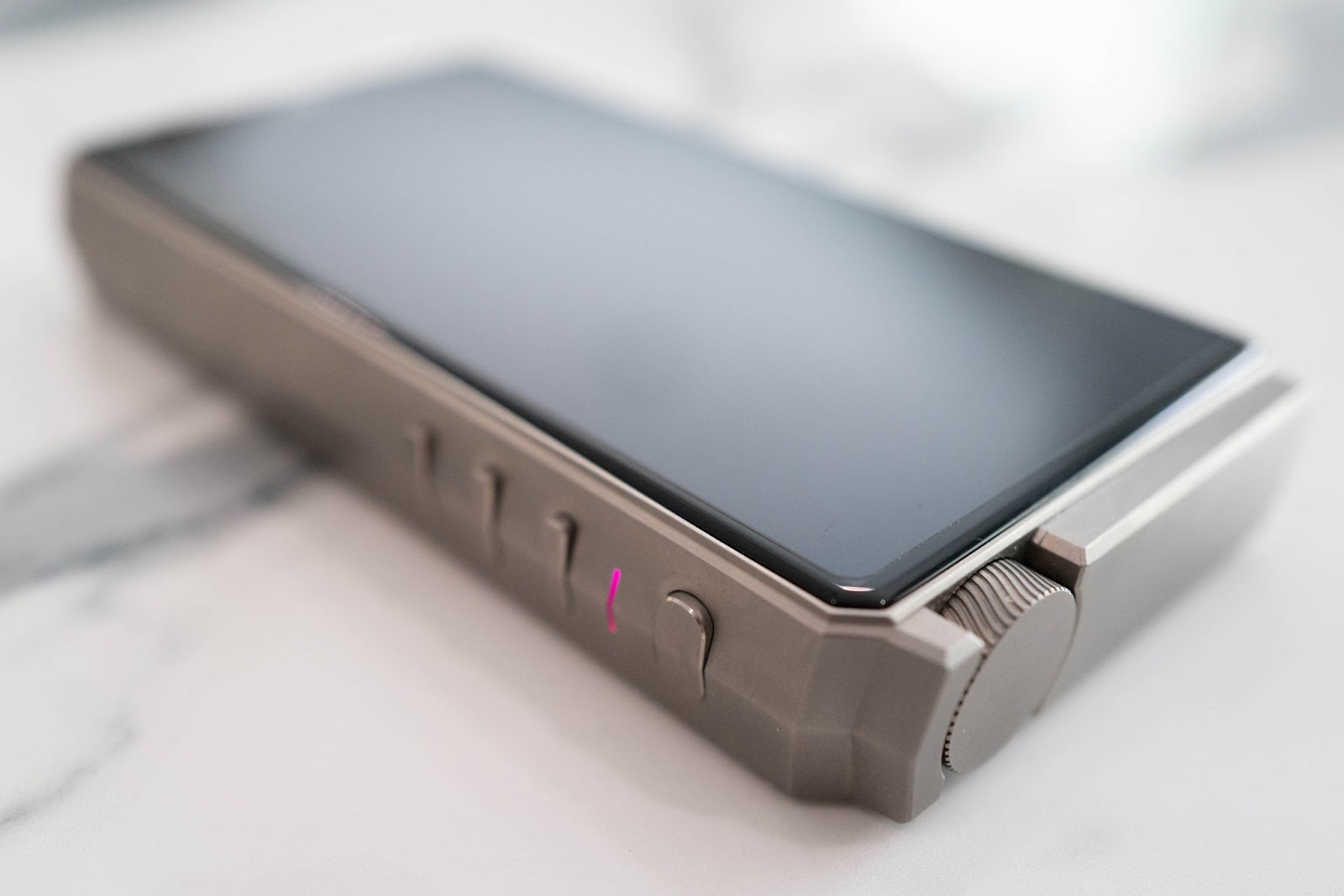
Unboxing and First Impressions
The RS8 is a premium, flagship DAP and the unboxing experience is among the most luxurious I’ve seen across any product in the high end personal audio space. Opening the shiny and reflective silver box, we’re greeted with a catchy “HIBY RS8” silver inscribed piece of translucent wax paper that is sat on top of a cloth drawstring bag which protects the leather storage case.
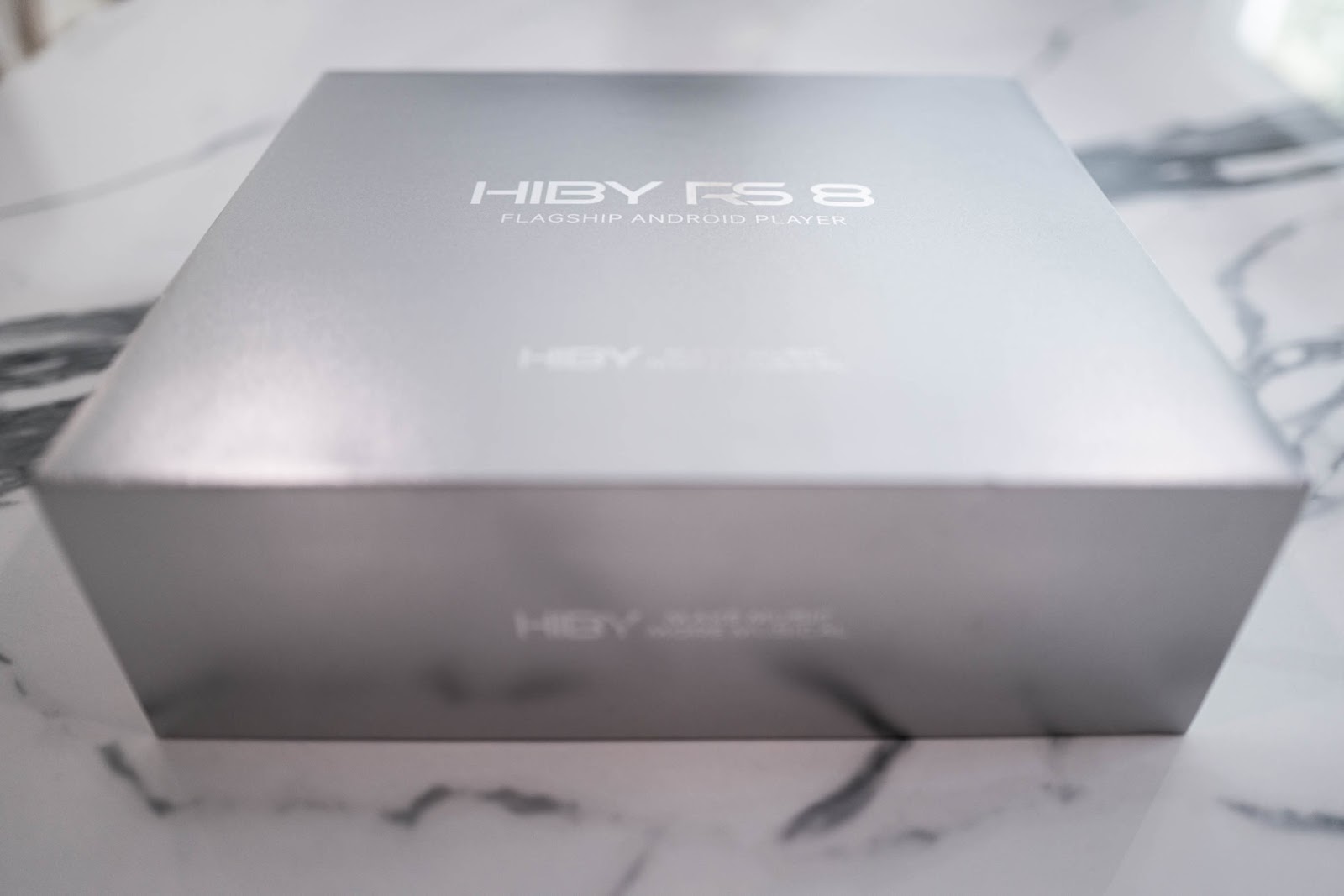


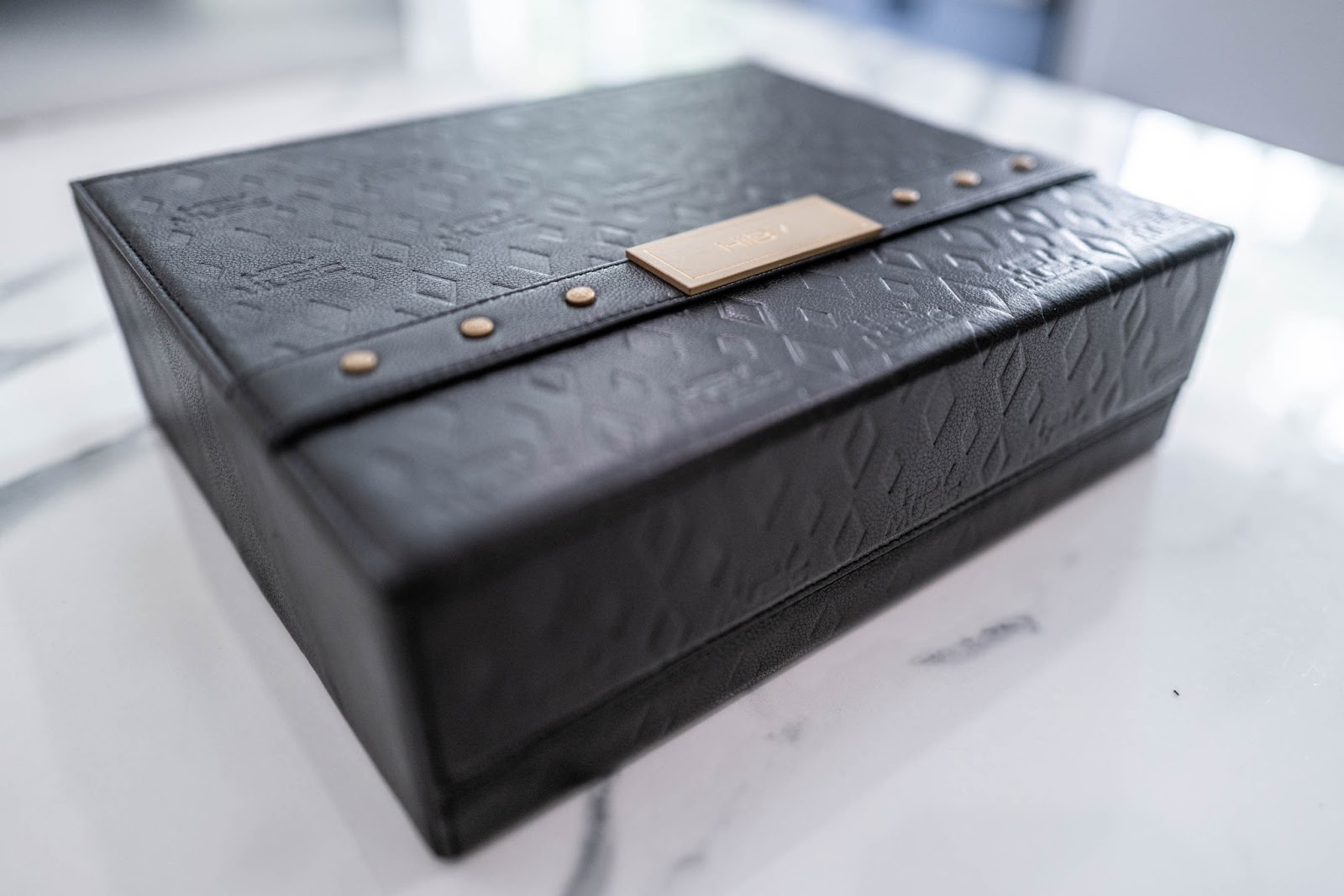
The case is beautifully adorned with HIBY branded decoration and feels ultra-premium in hand. Opening the magnetic latch case reveals the top shelf holding the RS8 unit itself, along with a lovely owner’s card, a branded piece of solid Titanium.
Removing the upper shelf reveals three boxes of Accessories which include a custom designed leather case, a USB-C charging cable, and a USB-C to digital coaxial cable. There is also an included envelope containing a quick start guide, warranty card, extra screen protector (one comes pre-installed on the unit), and a thank-you note from HiBy.

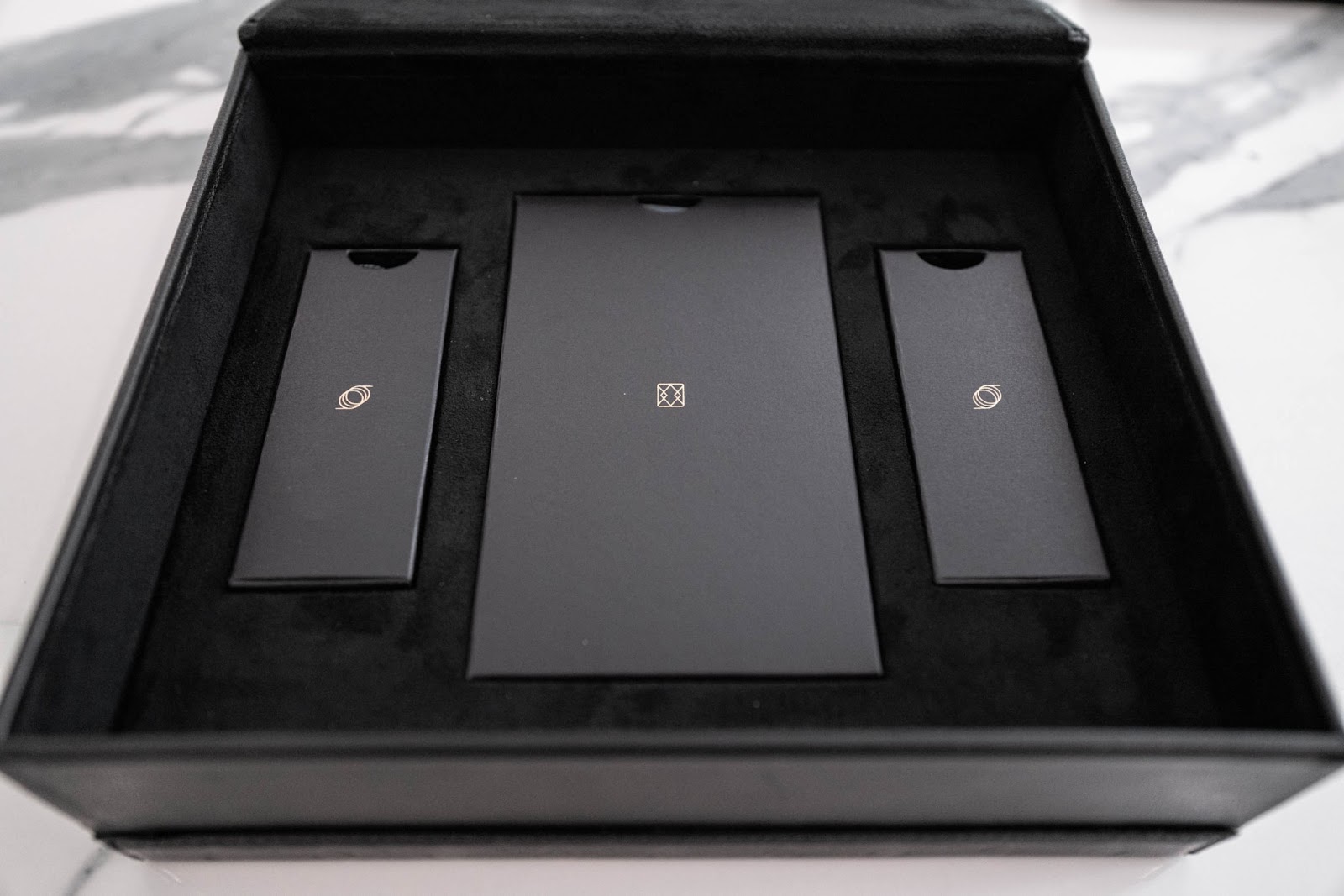
The leather case itself is a beautiful shade of blue with greenish tones and is precisely cut for a perfect and tight fit with the RS8. The back of the case contains a fairly large cut-out which enables the user to see the decorated back panel of the unit. I also noticed through usage, that the cutout made holding the RS8 easier, so this design choice has more than an aesthetic benefit.
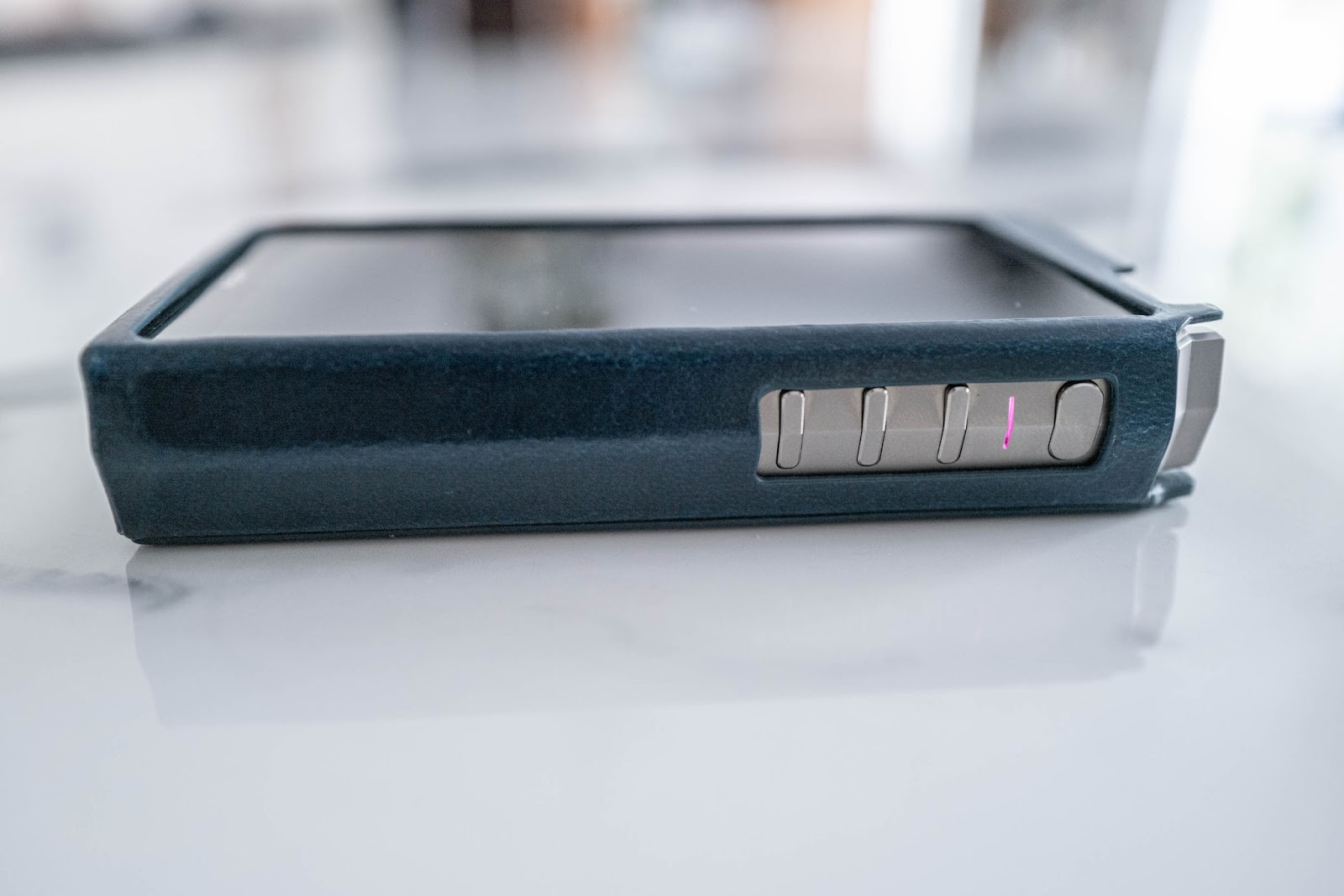

Picking up the actual unit itself, the RS8 is made from a solid block of titanium and has significant weight to it, coming in at just under 590 grams. The volume knob has perfectly machined notches and is without question, the nicest feeling volume control I’ve ever experienced on a portable device. It has just the right amount of resistance and is smooth as butter.
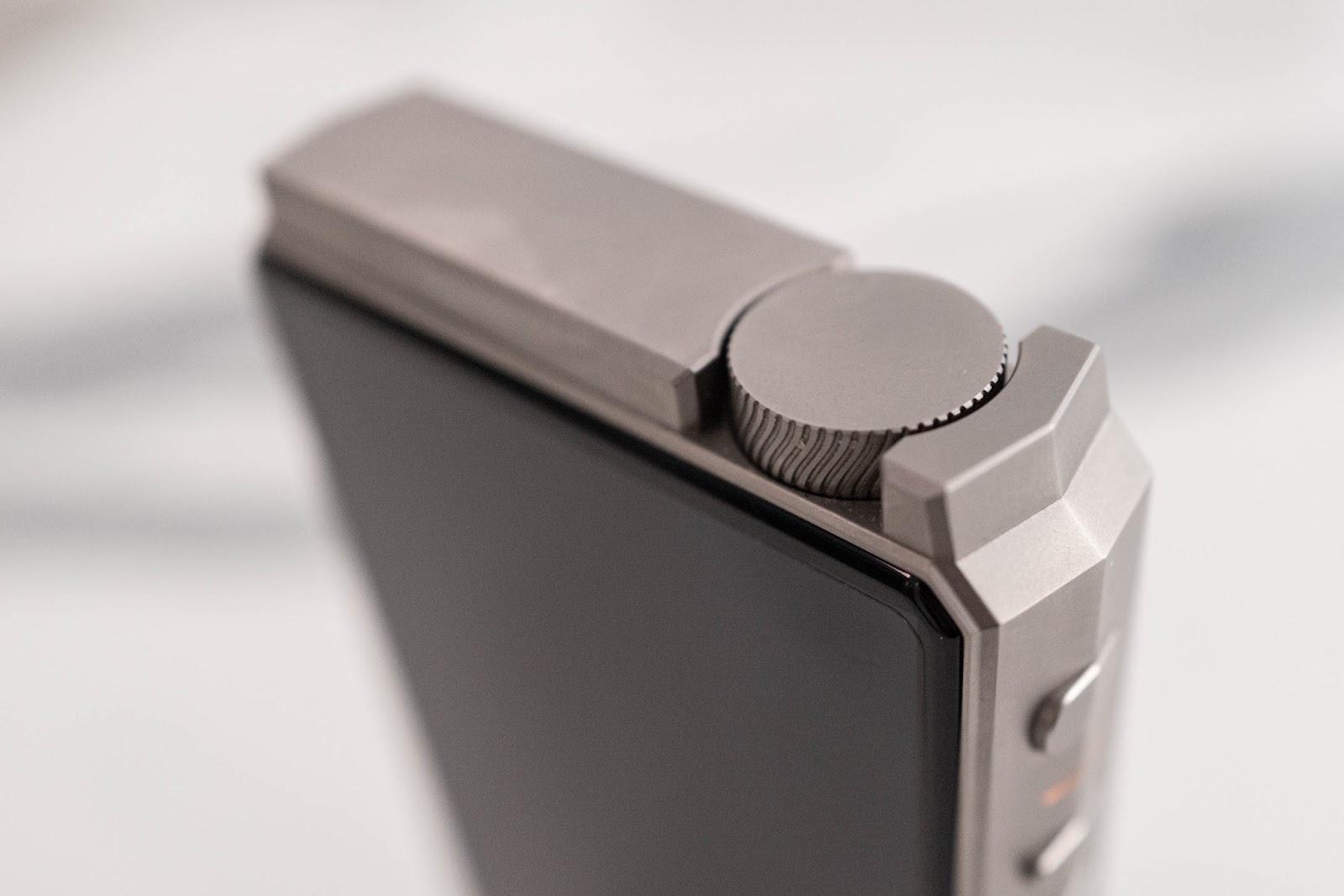
The sharp angles at the top of the unit highlight and accentuate the beauty of the titanium shell, which itself is velvety smooth to the touch. All of the ports on the RS8 are on the bottom of the unit and include 3.5mm and 4.4mm balanced and unbalanced outputs. There is also a USB-C port which charges the RS8 and also provides the coaxial connection using the supplied USB-C to coaxial cable.
The RS8 boasts a 5.5” 1080p IPS retina screen which has a 443 ppi density. The Android 12 interface is snappy and its open architecture allows for the adding of apps from the Google Play store. I added both the Tidal and YouTube apps and the overall interaction with the device feels similar to a modern Android smartphone. The RS8 comes with a screen protector pre-installed, and there is a second, spare screen protector included as well.
The right side of the RS8 has a power switch and three additional buttons, for playback/pause, forward, and backward with an LED indicator in between. The LED indicator will show different colors depending on the bitrate passing through. Flipping over, the left side features a MicroSD card slot which supports card sizes up to 2TB.
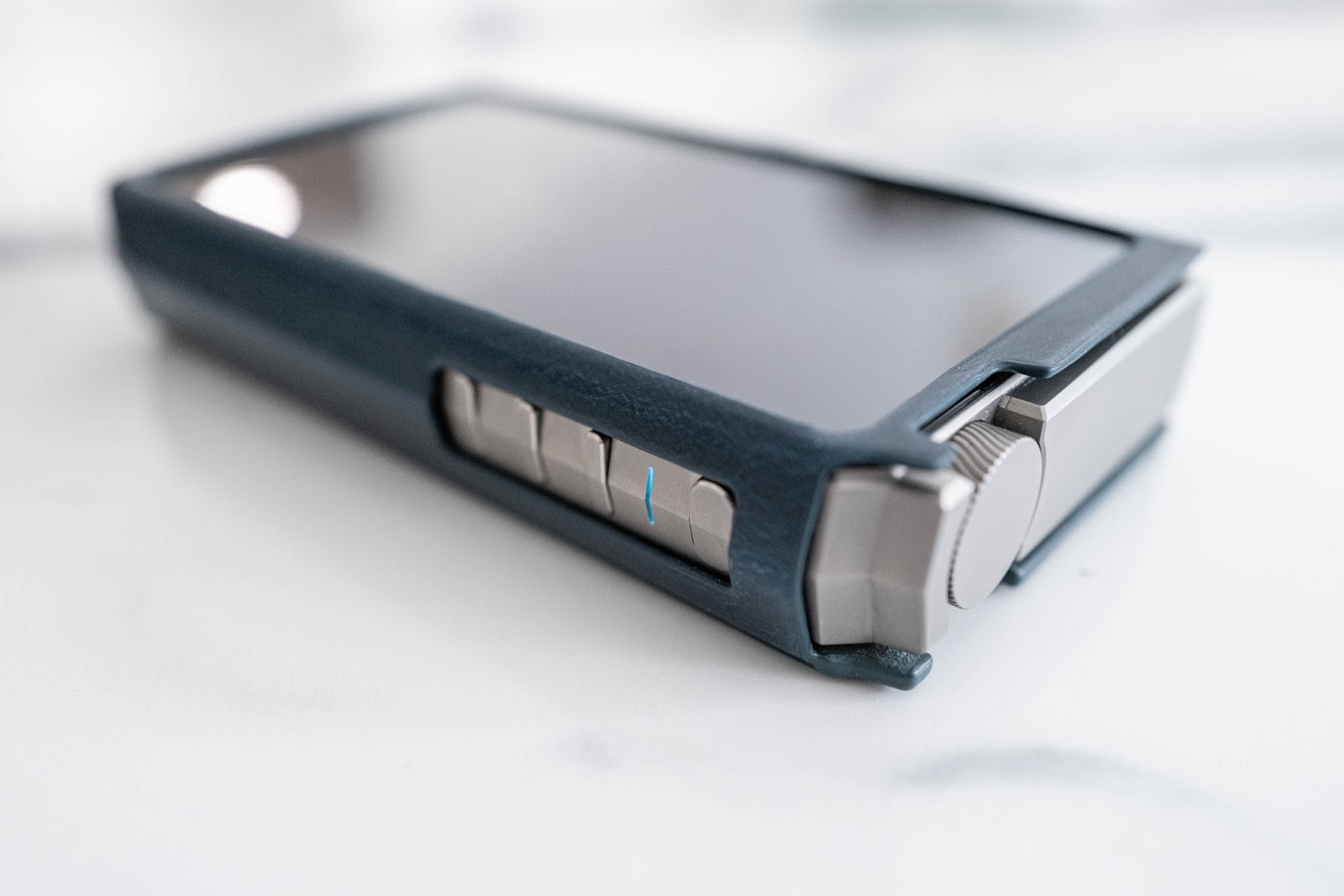
Setup and Operation
The RS8 uses an open Android 12 operating system, which provides the user with multiple options on how to listen to and stream music. I used the Google Play Store to download the Tidal app for music streaming and the UAPP player for listening to local files. There is also a fine default, and fully featured audio player called HiBy Music Pro.
I mostly used 2 different menus to tweak the sound to my liking, these were the Audio Settings Menu, and the Darwin Controller Menu. To access apps such as Tidal, UAPP, and YouTube, you can simply tap the app icon of the home screen, similar to a phone or tablet. To access Audio Settings and the Darwin Controller, all it takes is a simple swipe or double swipe down from the top of the unit. I liked the ease of access to these options without scrolling through menus as it made adjustments on the fly, quick and easy.
The Audio Settings Menu provides several options to tailor the sound. Throughout my listening impressions, I found myself adjusting settings depending on IEM used and on genre/recording quality of the music. There is an option to switch between Class A and Class AB modes, enabling Turbo mode, changing Gain levels, adjusting DSD Gain compensation, setting channel balance, and capping maximum volume. There is also an excellent built-in EQ in the MSEB settings menu, which enables subtle changes when needed.
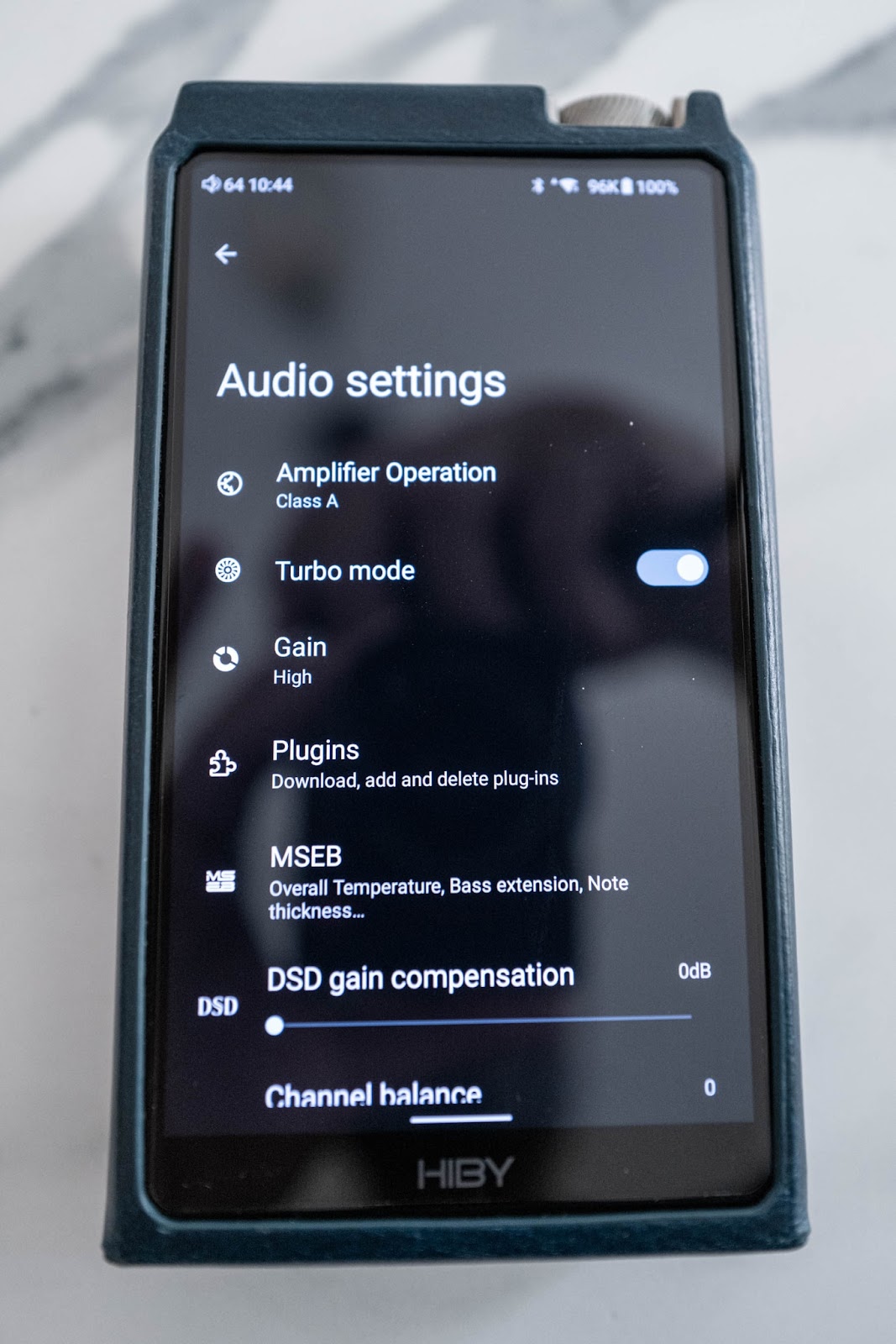
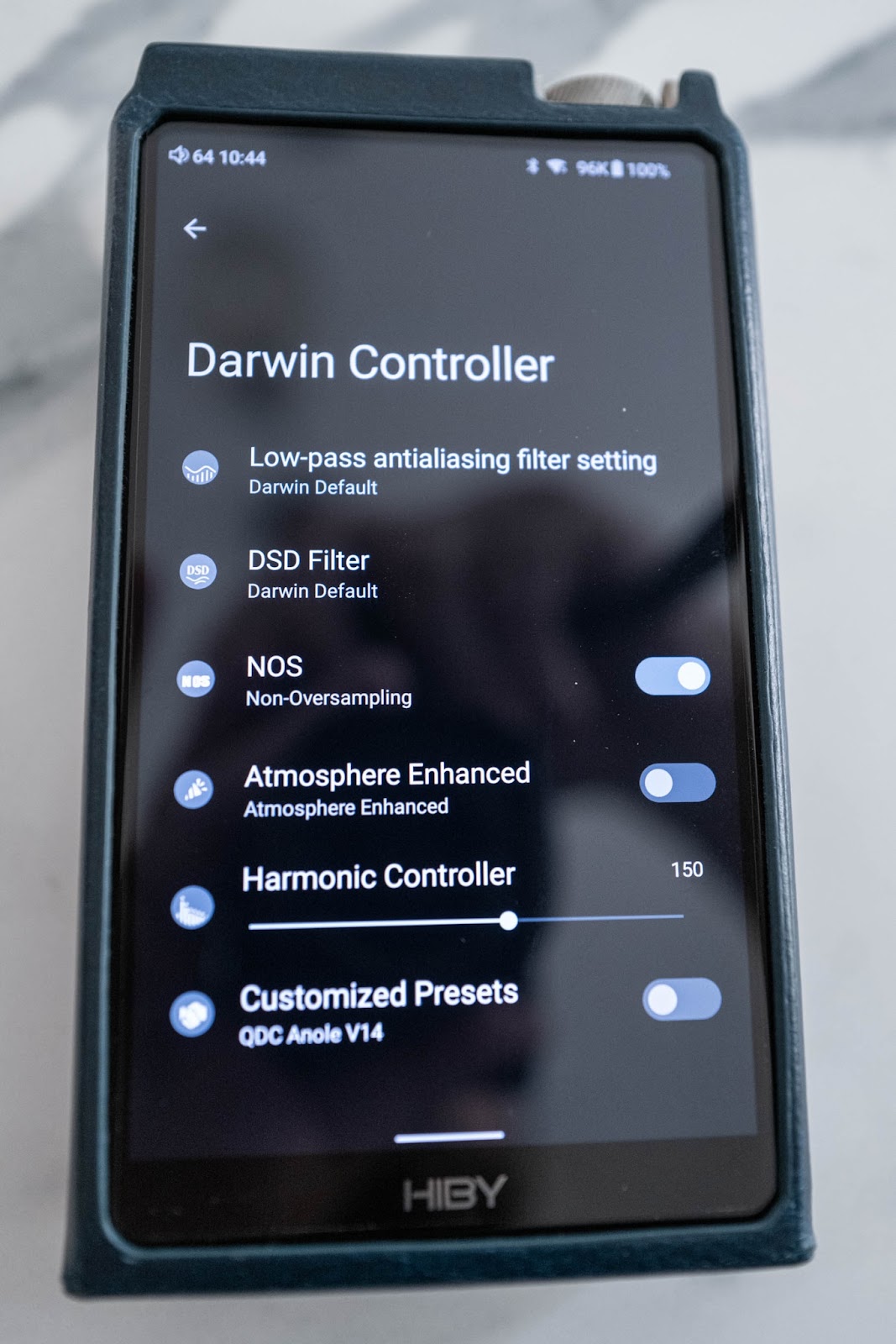
The Darwin Controller contains several options to customize various aspects of the digital signal. The main setting here is the toggle for non-oversampling (NOS) or if left off, oversampling. For the most part, I preferred the NOS setting as it sounded more natural and musical. The OS setting sounded perhaps a tad cleaner, but I felt it also gave up some of the “magic sauce” that I was hearing with the NOS setting engaged.
There are also filter presets for Low-pass antialiasing and DSD, an Atmosphere Enhanced toggle along with a Harmonic Controller, and Customized presets that contain a few popular IEMs, with more to come in future updates. Tweaking these settings resulted in some minor effects and it's great to have so many options on board.

Sound Impressions
For my listening impressions with the RS8, I used a Unique Melody Mentor Multiverse and a Vision Ears Elysium. The Elysium really comes to life with higher output power and the RS8 outputs up to 780mW when using the balanced output, and 280mW single ended, both into 32Ω. The RS8 was burned in for about 150 hours before doing any critical listening.
“I keep wanting to turn the volume up. Not because I can’t hear what’s going on, but because it sounds so damn good.” This just about sums it up for me. The RS8 is probably the most enjoyable DAP I’ve ever heard and reminded me of desktop listening sessions using tube amplification. There’s an inherent organic quality to the sound which is natural and realistic. In terms of overall tuning, I would describe the RS8 as warmer than neutral but still close to a reference tuning.
The RS8 has an incredibly black background and it is completely silent. Sounds have a wonderful textural quality to them that is simply engaging and left me wanting to keep listening. Detail retrieval is still excellent even with edges that are a little smooth and rounded. There was simply no sibilance or listening fatigue.
The Turbo mode provides a little more voltage swing and results in a more direct and engaging sound. I generally preferred the Turbo mode when wanting more overall energy in my listening. This was again, another feature that I found myself using a lot.
The Mentor is a new flagship IEM which has 12 BA drivers and a new frequency shift piezoelectric bone conduction driver. This IEM has a reference, warm neutral sound signature and pairs beautifully with the RS8. Listening mostly on low or medium gain settings, this combo shines with most everything I threw at it, even bass-heavy tracks where I had to EQ some of the bass frequency down just ever so slightly.
The Elysium has magic in its midrange and this was accentuated with the RS8. Here I could switch to a high gain setting and this combination was the best I’ve ever heard the Elysium sound. Music had a beautiful tone, with a little more relaxed yet still detailed treble.
On both IEMs, the soundstage was not only wide but also had depth and had more dimensionality than I’m used to hearing from portable audio devices. Here again, this reminded me of higher end desktop listening.
Overall, I’m really impressed with the sound quality of the RS8 and it is without a doubt, one of the best portable audio devices I’ve ever heard.
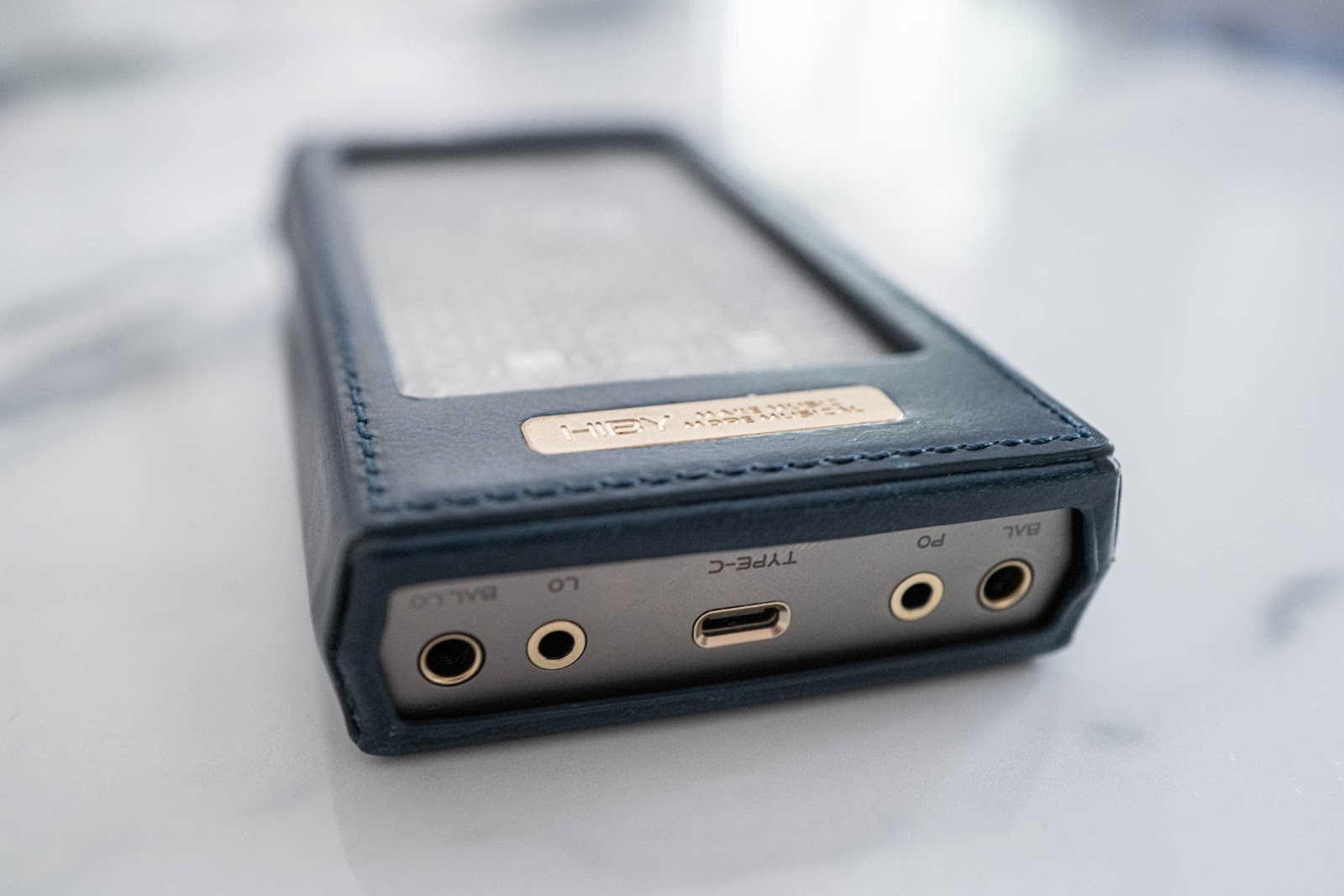
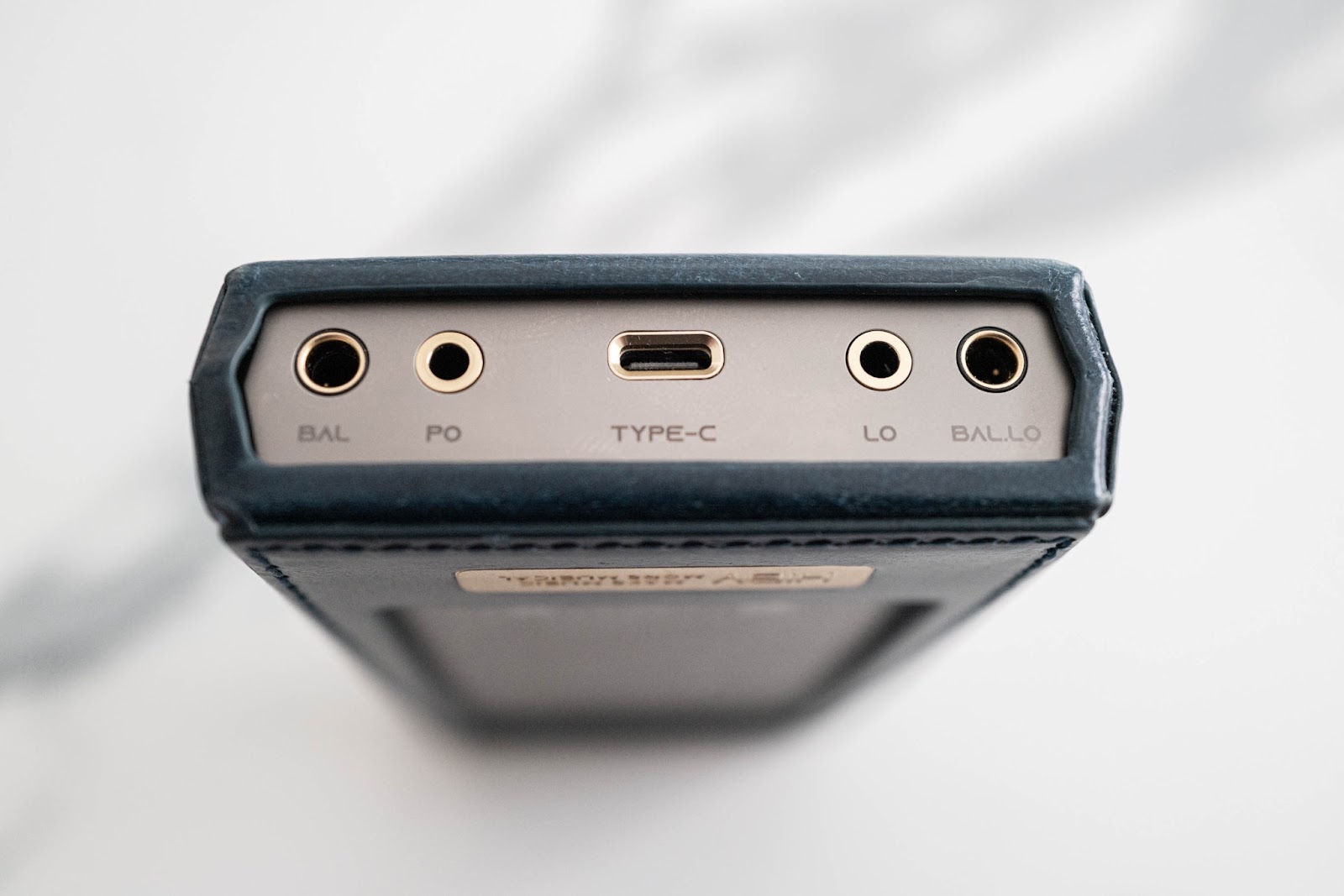
Conclusion
With the RS8, HiBy now has a strong contender in the flagship DAP category. In addition to its highly impressive physical and technical features, the RS8 has a beautiful and natural, organic quality to its sound signature. While naturally appealing to traditional R2R DAC fans, I believe the RS8 will likely appeal to any enthusiast looking for a flagship portable DAP. There is just an inherent quality to listening to music through this device which reminds me of listening to music with a high quality tube amplifier. Never harsh, detailed yet musical, and incredibly enjoyable. When you add in the beautiful Titanium construction, open Android 12, and a great screen and UI, this makes the overall package even more compelling.
I highly recommend auditioning the RS8 for anyone in the market for a flagship level DAP in 2023.
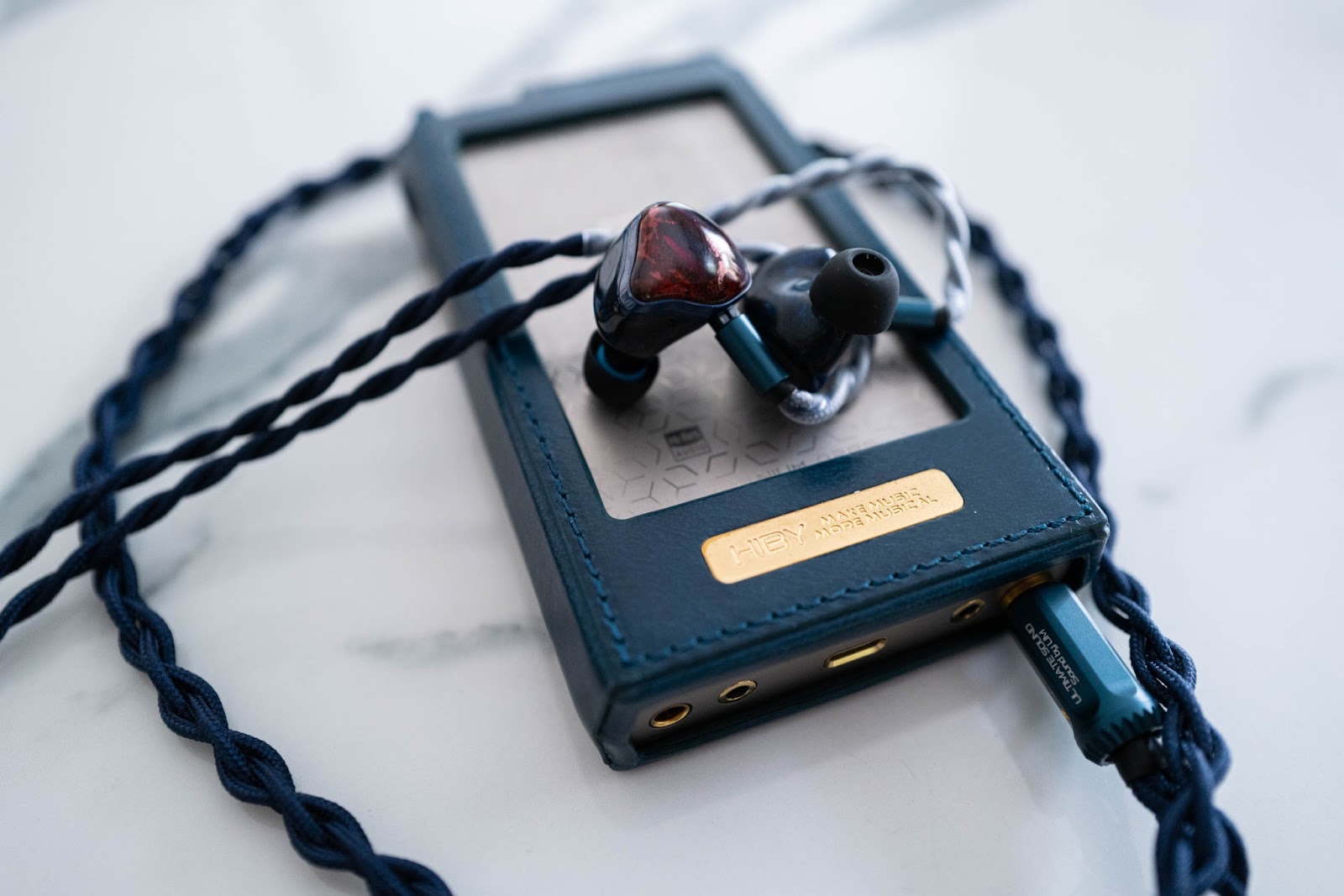
The flagship DAP market has gotten really interesting over the last few years. Once a near exclusive purview of Astell&Kern, with a smattering of Sony on top, the market has since expanded to include the likes of Cayin, Luxury & Precision, and now HiBy, among others.
Most flagship DAPs are traditional chip/based DACs which pursue varying degrees of reference type sound signatures. In an effort to appeal to enthusiasts looking for a wider variety of personal listening preferences, Cayin released their N8 series in 2018 which enabled the user to choose between tube and solid state amplification. The flagship market further expanded when Luxury & Precision released their first fully discrete R2R ladder DACs, the P6 and P6 Pro in late 2020.
Guangdong-based HiBY Music was established in 2011, primarily as a digital music provider, and in recent years has developed its own line of DAP hardware products. Initially targeting budget-minded consumers, the company rapidly shifted to focus on the midrange and upper end of the market with the 2020-released R8 and 2021-released RS6. The RS6 was also HiBy’s first R2R DAP.
R2R (resistor-to-resistor) DACs use a series of resistors to convert digital signals into analog signals. R2R DACs have been traditionally used in desktop applications, yet they are now becoming more popular in the DAP market. R2R designs typically bring a more natural, non-fatiguing, and organic presentation to the table. Which is especially important for those that are sensitive to sibilance or harshness in the frequency response.
The R8 and RS6 were both highly regarded and excellent products in their own right, and were the stepping stones for HiBy to finally bring a true flagship audio player to market. With the introduction of the all-new RS8, HiBy has clearly set out to compete at the top end of the market with a no compromise design, and is packed to the gills with features. Those who attended CanJam SoCal 2022 had a chance to demo the new RS8 and for many, it was the best sounding DAP at the show.
The RS8 has a flagship DAP price and retails for $3,299 and is the most expensive HiBy DAP to date.
Some notable features of the HiBy RS8 include:
- Snapdragon 665 processor
- HiBY’s in-house developed Darwin II architecture
- NOS/OS mode switch enabling the user to change between non-oversampling mode and oversampling mode
- Audio-dedicated Femtosecond Crystal Oscillators
- Massive 12000mAH lithium-polymer battery
- Class A and AB amplification modes
- Switchable Turbo mode for an additional 1.5V power output
- Open Android 12 architecture
- 5.5” 1080P IPS retina touchscreen with 443 PPI
- 8GB RAM and 256GB internal storage
- Custom HiByOS with open Android 12, Google Play Store
- Quick charge support with up to 20W fast charging
Unboxing and First Impressions
The RS8 is a premium, flagship DAP and the unboxing experience is among the most luxurious I’ve seen across any product in the high end personal audio space. Opening the shiny and reflective silver box, we’re greeted with a catchy “HIBY RS8” silver inscribed piece of translucent wax paper that is sat on top of a cloth drawstring bag which protects the leather storage case.
The case is beautifully adorned with HIBY branded decoration and feels ultra-premium in hand. Opening the magnetic latch case reveals the top shelf holding the RS8 unit itself, along with a lovely owner’s card, a branded piece of solid Titanium.
Removing the upper shelf reveals three boxes of Accessories which include a custom designed leather case, a USB-C charging cable, and a USB-C to digital coaxial cable. There is also an included envelope containing a quick start guide, warranty card, extra screen protector (one comes pre-installed on the unit), and a thank-you note from HiBy.
The leather case itself is a beautiful shade of blue with greenish tones and is precisely cut for a perfect and tight fit with the RS8. The back of the case contains a fairly large cut-out which enables the user to see the decorated back panel of the unit. I also noticed through usage, that the cutout made holding the RS8 easier, so this design choice has more than an aesthetic benefit.
Picking up the actual unit itself, the RS8 is made from a solid block of titanium and has significant weight to it, coming in at just under 590 grams. The volume knob has perfectly machined notches and is without question, the nicest feeling volume control I’ve ever experienced on a portable device. It has just the right amount of resistance and is smooth as butter.
The sharp angles at the top of the unit highlight and accentuate the beauty of the titanium shell, which itself is velvety smooth to the touch. All of the ports on the RS8 are on the bottom of the unit and include 3.5mm and 4.4mm balanced and unbalanced outputs. There is also a USB-C port which charges the RS8 and also provides the coaxial connection using the supplied USB-C to coaxial cable.
The RS8 boasts a 5.5” 1080p IPS retina screen which has a 443 ppi density. The Android 12 interface is snappy and its open architecture allows for the adding of apps from the Google Play store. I added both the Tidal and YouTube apps and the overall interaction with the device feels similar to a modern Android smartphone. The RS8 comes with a screen protector pre-installed, and there is a second, spare screen protector included as well.
The right side of the RS8 has a power switch and three additional buttons, for playback/pause, forward, and backward with an LED indicator in between. The LED indicator will show different colors depending on the bitrate passing through. Flipping over, the left side features a MicroSD card slot which supports card sizes up to 2TB.
Setup and Operation
The RS8 uses an open Android 12 operating system, which provides the user with multiple options on how to listen to and stream music. I used the Google Play Store to download the Tidal app for music streaming and the UAPP player for listening to local files. There is also a fine default, and fully featured audio player called HiBy Music Pro.
I mostly used 2 different menus to tweak the sound to my liking, these were the Audio Settings Menu, and the Darwin Controller Menu. To access apps such as Tidal, UAPP, and YouTube, you can simply tap the app icon of the home screen, similar to a phone or tablet. To access Audio Settings and the Darwin Controller, all it takes is a simple swipe or double swipe down from the top of the unit. I liked the ease of access to these options without scrolling through menus as it made adjustments on the fly, quick and easy.
The Audio Settings Menu provides several options to tailor the sound. Throughout my listening impressions, I found myself adjusting settings depending on IEM used and on genre/recording quality of the music. There is an option to switch between Class A and Class AB modes, enabling Turbo mode, changing Gain levels, adjusting DSD Gain compensation, setting channel balance, and capping maximum volume. There is also an excellent built-in EQ in the MSEB settings menu, which enables subtle changes when needed.
The Darwin Controller contains several options to customize various aspects of the digital signal. The main setting here is the toggle for non-oversampling (NOS) or if left off, oversampling. For the most part, I preferred the NOS setting as it sounded more natural and musical. The OS setting sounded perhaps a tad cleaner, but I felt it also gave up some of the “magic sauce” that I was hearing with the NOS setting engaged.
There are also filter presets for Low-pass antialiasing and DSD, an Atmosphere Enhanced toggle along with a Harmonic Controller, and Customized presets that contain a few popular IEMs, with more to come in future updates. Tweaking these settings resulted in some minor effects and it's great to have so many options on board.
Sound Impressions
For my listening impressions with the RS8, I used a Unique Melody Mentor Multiverse and a Vision Ears Elysium. The Elysium really comes to life with higher output power and the RS8 outputs up to 780mW when using the balanced output, and 280mW single ended, both into 32Ω. The RS8 was burned in for about 150 hours before doing any critical listening.
“I keep wanting to turn the volume up. Not because I can’t hear what’s going on, but because it sounds so damn good.” This just about sums it up for me. The RS8 is probably the most enjoyable DAP I’ve ever heard and reminded me of desktop listening sessions using tube amplification. There’s an inherent organic quality to the sound which is natural and realistic. In terms of overall tuning, I would describe the RS8 as warmer than neutral but still close to a reference tuning.
The RS8 has an incredibly black background and it is completely silent. Sounds have a wonderful textural quality to them that is simply engaging and left me wanting to keep listening. Detail retrieval is still excellent even with edges that are a little smooth and rounded. There was simply no sibilance or listening fatigue.
The Turbo mode provides a little more voltage swing and results in a more direct and engaging sound. I generally preferred the Turbo mode when wanting more overall energy in my listening. This was again, another feature that I found myself using a lot.
The Mentor is a new flagship IEM which has 12 BA drivers and a new frequency shift piezoelectric bone conduction driver. This IEM has a reference, warm neutral sound signature and pairs beautifully with the RS8. Listening mostly on low or medium gain settings, this combo shines with most everything I threw at it, even bass-heavy tracks where I had to EQ some of the bass frequency down just ever so slightly.
The Elysium has magic in its midrange and this was accentuated with the RS8. Here I could switch to a high gain setting and this combination was the best I’ve ever heard the Elysium sound. Music had a beautiful tone, with a little more relaxed yet still detailed treble.
On both IEMs, the soundstage was not only wide but also had depth and had more dimensionality than I’m used to hearing from portable audio devices. Here again, this reminded me of higher end desktop listening.
Overall, I’m really impressed with the sound quality of the RS8 and it is without a doubt, one of the best portable audio devices I’ve ever heard.
Conclusion
With the RS8, HiBy now has a strong contender in the flagship DAP category. In addition to its highly impressive physical and technical features, the RS8 has a beautiful and natural, organic quality to its sound signature. While naturally appealing to traditional R2R DAC fans, I believe the RS8 will likely appeal to any enthusiast looking for a flagship portable DAP. There is just an inherent quality to listening to music through this device which reminds me of listening to music with a high quality tube amplifier. Never harsh, detailed yet musical, and incredibly enjoyable. When you add in the beautiful Titanium construction, open Android 12, and a great screen and UI, this makes the overall package even more compelling.
I highly recommend auditioning the RS8 for anyone in the market for a flagship level DAP in 2023.
Last edited:
Maxx134
IMO, RS8 is better... SP3000 is a bit upgrade from past AKM chip sound. RS8 Also better than LP6, N8ii, they both stand a bit in it's shadow.
RS8 a bit noticably different. Very real and expansive "desktop level" R2R sound.
RS8 a bit noticably different. Very real and expansive "desktop level" R2R sound.
1
111MilesToGo
Excellent! Thanks.
rpade
How does the RS8 compare to the P6 Pro? They’re the biggest R2R DAPs in the market!


You need to give MSEB or audio plugins->DRX10K a try
https://www.head-fi.org/threads/introducing-the-all-new-hiby-drx10k.968627/
The Darwin settings, DSD filters etc. are indeed there to give those who don't want to EQ or use audio plugins (which basically means they don't want to alter the sound) a sense that they're altering the sound, without... altering the sound (much, and you can't technically do much with AA filters in the first place). Audiophiles are an internally conflicted lot. But check out the Darwin V2 filters, there's more variety there esp. with the Darwin Ultra: https://www.head-fi.org/threads/pro...ers-v2-for-hiby-rs6-rs8-rs2-fc6.969083/page-2